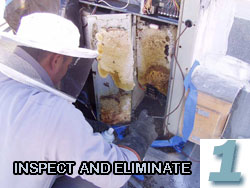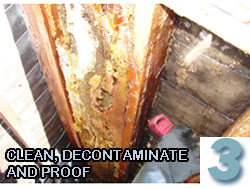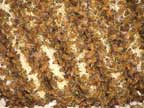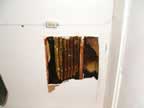![]()
![]()
![]()
![]()
Cash
&
Check
For
the Best Bee Removal in Southern California
Call toll free 877-4ABOLISH
877-422-6547
Abolish Your Bee Problems!
Abolish Provides a wide range of Bee Control Services. We only use the best products and techniques when dealing with bees and other insects. Read below for more on what we do. We Do RESIDENTIAL, COMMERCIAL, and INDUSTRIAL Bee Control--Check the Service Area
"Killer Bees" | Honey Bees | Bee Hives | Nests in Walls | Watch bee videos here
Abolish Pest Control are professionals when it comes to identifying the problem, removing the bees, and removing bee hives. Bee Control is what we do. With rising concerns of the Africanized bee (killer bee) more people are now looking to control their bee problems rather than avoid them. Unlike other conventional pest control companies who only kill the bees but don't fully solve the problem, we find the hive, remove the bees, remove the hive and prevent future infestations of the area. That is true bee control! Our Bee Control technicians are fully trained and are professionals when it comes to dealing with bees. Please do not attempt to remove bees or bee hives without the proper equipment and experience. Give us a call. We service Southern California for Bee Control
There are three major steps to follow in completely removing bees.
If a company does not offer one of these three then they are risking damage to your home as well as harm to you.
 First, we locate
the bees and eliminate them.
Proper inspection is essential in finding the bees and their hive. Many companies who do not properly inspect or eliminate bees, miss old hives or
allow the hive to rebuild. Walls are a common place for bees but can be a difficult place to completly remove them from.
First, we locate
the bees and eliminate them.
Proper inspection is essential in finding the bees and their hive. Many companies who do not properly inspect or eliminate bees, miss old hives or
allow the hive to rebuild. Walls are a common place for bees but can be a difficult place to completly remove them from.
 Second, once eliminated we remove the dead bees,
honey, and hive.
Beware of companies that simply kill the bees and leave the hive. The damage will be costly if not removed immediatly.
Second, once eliminated we remove the dead bees,
honey, and hive.
Beware of companies that simply kill the bees and leave the hive. The damage will be costly if not removed immediatly.
 Lastly, cleaning and proofing the area infested by bees is important to prevent future infestations of either bees or other
pests attracted to the honey.
without proper cleaning,
Lastly, cleaning and proofing the area infested by bees is important to prevent future infestations of either bees or other
pests attracted to the honey.
without proper cleaning,
Our goal for our bee removal service is to make sure you don't have the same problem again. If you have been calling a company repeatedly for the same problem it is time to call us to get rid of your bee problem once and for all. Most of the time customers call us because they are fed up with their old pest control companies who fail to solve the problems. Watch our Bee Videos to see more of what we do.
![]() BEE ALERT
BEE ALERT
- Beware the Busy Bee
Most bees found in California are earnest, hard working types who much prefer the joys of simple labor to swaggering around like a schoolyard bully looking for people to intimidate. Having their work interrupted or their flight path blocked by a hysterical human flailing away like a windmill is not their idea of a good time, and may frighten or irritate them into stinging whoever is doing the flailing.
Killer Bee
 In appearance, killer bees resemble any other honey bee. It's their behavior
that sets them apart. They are a problem in California. Unlike the European honey bee, the Africanized
bee can be easily aggravated. The killer bee has been on a journey from
South America to North America since 1957. The first reported case in
the USA was in 1990 by 1994 they reached California, and moving at a rate
of 200 miles per year you would think they would have overwhelmed the
continent by now. Their expansion rate has been drastically reduced thanks
to professional bee control companies who have crews specializing in bee
control.
In appearance, killer bees resemble any other honey bee. It's their behavior
that sets them apart. They are a problem in California. Unlike the European honey bee, the Africanized
bee can be easily aggravated. The killer bee has been on a journey from
South America to North America since 1957. The first reported case in
the USA was in 1990 by 1994 they reached California, and moving at a rate
of 200 miles per year you would think they would have overwhelmed the
continent by now. Their expansion rate has been drastically reduced thanks
to professional bee control companies who have crews specializing in bee
control.
(http://en.wikipedia.org/wiki/Image:Killerbees_ani.gif)
In the past few years, a small number of Africanized "killer bees" have been found in the southern San Joaquin Valley, having migrated from Brazil. Because of cross-breeding in South America, they are now known as Brazilian honey bees. Killer bees are dangerous despite the new name, They will attack anything moving within 100 yards of their nest without provocation, and will chase a running target much farther than less excitable varieties of bees.
Africanized bees are a hybrid bee of the very aggressive african bee in Africa. The African bees, through evolution, have developed an aggressive nature to survive. The benefits of such bees is the hard working attribute and the ability to adapt to more tropical climates. In hopes of combining the hard working African bee and the friendly honey bee, biologist Warwick E. Kerr had interbred honey bees from Europe and southern Africa. Accidental release of the bees meant spread of the hybrid bees from Brazil to Texas, Arizona, New Mexico, Florida and Southern California.
 Honey Bee - Identify your enemy
Honey Bee - Identify your enemy
European bees for the most part are not a threat unless aggravated. Aggravation
will occur if they feel their hive is in danger. Swatting at flying bees
is not recommended since all you will accomplish is to aggravate them.
Unlike the European honey bee, the Africanized bee does not need an excuse
to attack. They protect their hive and queen at a larger radius. Again
unlike the European honey bee, the Africanized bee may pursue intruders
for up to a mile and remain aggravated for up to 24 hours
The most common stinging bee in California is the honey bee, introduced into this country from Europe in the 17th century. Its stinger, which resembles a hypodermic needle with barbs, is used to inject a mixture of alkali venom and acid into the skin. The alkali venom contains several kinds of proteins and enzymes which are believed to cause allergic reactions of varying degrees in humans. Sting reactions, which may increase with succeeding stings, include:
- A choking sensation or difficulty in breathing.
- A skin rash similar to hives (human hives, not bee hives).
- A dry cough, sneezing or asthma.
- Lips turning blue.
- A rapid pulse and a drop in blood pressure.
More severe reactions may include cramps, diarrhea, vomiting, shock or loss of consciousness. Symptoms usually appear within a few minutes after a sting, but could be delayed up to 24 hours. Stings near the eyes, nose and throat are the most dangerous. For severe reactions, medical assistance should be sought immediately.
When stung by a bee, the stinger should be removed as quickly as possible, but removing it improperly will make the sting worse, The proper way is to scrape the stinger out with a clean fingernail or knife. Pulling or squeezing the stinger will only pump more venom into the wound, as the bee parts containing the venom are left attached to the stinger after the bee tears itself free.
The sting area should be cleaned with soap and water, or with an antiseptic. For people known to have severe reactions who are stung on the arms or legs, a tourniquet may be applied between the wound and the heart to prevent the rapid spread of venom. The tourniquet should be released every three to five minutes until medical help is available.
Bees are affected by the type of clothing people wear. for some reason, rough and dark clothing of wool or leather irritates them, which is why professional bee keepers wear light colored, smooth textured clothes when tending their hives. Some perfumes also aggravate bees, which will attack a moving target faster than they will an immobile one. Running or swatting at them only increases the chances of a sting.
So when a bee draws near, try to relax. It will probably lose interest in you once it finds out you are not a gladiola -- or an enemy.
 Beehives can be found in almost any crevice large enough to hold a hive. We have found hives in HVAC units, pots, bird houses, walls, chimneys, attics, trash cans, lids, etc- the list goes on. If the beehive does not pose any threat and is far from any human activity then leaving it to its duty is recommended. If the beehive is a hazard and has nested in your structure then immediate removal is recommended. While moving cautiously around beehives will render yourself neutral to a bee, sudden movements will aggravate and provoke bees into defending their hive. On the other hand, Africanized honey bees will attack an intruder within a hundred yard radius. The aggression of these bees is dangerous especially to the elderly, children and those who are less likely to escape an attack. If you see bees flying around your house or know they have nested, then simply ignoring it will cost you more in the long run. Immediate removal is recommended. Check out our videos for more.
Beehives can be found in almost any crevice large enough to hold a hive. We have found hives in HVAC units, pots, bird houses, walls, chimneys, attics, trash cans, lids, etc- the list goes on. If the beehive does not pose any threat and is far from any human activity then leaving it to its duty is recommended. If the beehive is a hazard and has nested in your structure then immediate removal is recommended. While moving cautiously around beehives will render yourself neutral to a bee, sudden movements will aggravate and provoke bees into defending their hive. On the other hand, Africanized honey bees will attack an intruder within a hundred yard radius. The aggression of these bees is dangerous especially to the elderly, children and those who are less likely to escape an attack. If you see bees flying around your house or know they have nested, then simply ignoring it will cost you more in the long run. Immediate removal is recommended. Check out our videos for more.
 Honey
bees may establish a nest inside the wall of the house or other building
causing a problem, a health hazard and a serious danger to the structure.
Honey
bees may establish a nest inside the wall of the house or other building
causing a problem, a health hazard and a serious danger to the structure.
Honey bee colonies in wall or attic voids are a much more serious problem than yellowjacket wasps. Yellowjacket colonies are annual and the wasps will disappear in the winter with or without treatment. Honey bee nests may last for many years without treatment and will contain honey stored inside the walls. The honey can ruin walls and ceilings if it is not removed.
Salvaging honey bee colonies from wall voids is usually not practical, so extermination is recommended. Wild honey bees are of very little or no value to a professional bee keeper as they are often heavily infested with parasites and diseases.
Combs inside buildings should be removed to avoid problems with honey-stained walls and pest problems, such as carpet beetles, and attracting bee swarms in the future. Never use honey or wax from colonies that have been treated with an insecticide. Controlling honey bee nests can be challenging. Call a pest control specialist if you spot bees around or coming out of your home.
We are specialists when it comes to dealing with honey bees, yellowjackets, and their nests. Our Bee Control will leave no trace of bees in the present or future.
Call
toll free 877-4ABOLISH
877-422-6547
home
| specials | commercial
| residential | service
area
preparation | pests
| feedback | contact
us
Abolish Pest Control Co. Absolutely no rights of distribution by sale or other transfer of
ownership or by rental, lease or lending, preparation of derivative works,
or reproduction, in whole or in part, is not granted. No text, graphics
or photos may be downloaded and used on another Internet site, without
express permission of AbolishPestControl. For information on obtaining
photo usage and rights, please see our contact
page. AbolishPestControl reserves the rights to actively protect against
infringement. bee control bee control bee control bee control bee control
bee control bee control and bee removal bee removal bee removal bee removal
bee hive removal bee hive removal hive removal bee removal
Copyright ©1985 - 2019 AbolishPestControl.com All Rights Reserved